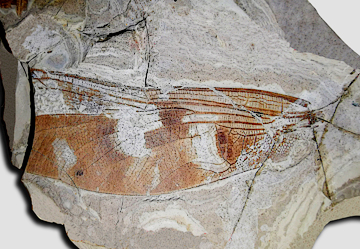Abstract
Psyllinae, a subfamily of Psyllidae, currently includes 29 genera (Burckhardt & Ouvrard, 2012; Ouvrard, 2018), of which Cacopsylla Ossiannilsson, 1970 is the most species-rich genus, distributed mainly in the Northern Hemisphere (Li, 2011; Ouvrard, 2018). In China, more than 300 extant species of Cacopsylla have been reported (Yang et al., 2004; Li, 2011; Luo et al., 2012, 2016). Based on recent molecular phylogenetic analyses, Cacopsylla in its current sense is a polyphyletic genus (Percy et al., 2018; Cho et al., 2019).
References
Amyot, C.J.B. & Audinet-Serville, M.J.G. (1843) Histoire naturelle des insectes. Hémiptères. Librairie Encyclopédique de Roret, Paris (France), 675 pp.
Becker-Migdisova, E.E. (1964) Treticnye ravokrylye Stravropol’ja. Trudy Paleontologicheskogo Instituta Moskva, 54, 1–104.
Brown, R.G. & Hodkinson, I.D. (1988) Taxonomy and ecology of the jumping plant-lice of Panama (Homoptera: Psylloidea). Entomonograph, 9, 304 pp.
https://doi.org/10.1163/156853988X00241
Burckhardt D. & Ouvrard, D. (2012) A revised classification of the jumping plant-lice (Hemiptera: Psylloidea). Zootaxa, 3509, 1–34.
https://doi.org/10.11646/zootaxa.3509.1.1
Cho, G., Malenovský, I. & Lee, S. (2019) Higher-level molecular phylogeny of jumping plant lice (Hemiptera: Sternorrhyncha: Psylloidea). Systematic Entomology, 44, 638–651.
https://doi.org/10.1111/syen.12345
Fang, X., Yan, M. & Van der Voo, R. (2005) Late Cenozoic deformation and uplift of the Tibetan Plateau, Evidence from high-resolution magnetostratigraphy of the guide basin, Qinghai province, China. Geological Society of America Bulletin, 117, 1208–1225.
https://doi.org/10.1130/B25727.1
Guo, S.X. (1980) Miocene flora in Zekog county of Qinghai. Acta Palaeontologica Sinica, 19, 406–412.
Hodkinson, I.D. & White, I.M. (1979) Homoptera Psylloidea. Handbooks for the Identification of British Insects. Royal Entomological Society, London, 7 (5a), i–iv, 1–98.
Klimaszewski, S.M. (1993) New species of Miocene psyllids (Homoptera, Psylloidea). Acta Biologica Silesiana, 22 (39), 19–29.
Latreille, P.A. (1807) Genera crustaceorum et insectorum secundum ordinem naturalem in familias disposita, iconibus exemplisque plurimis explicata. Tomus tertius. A. Koenig, Pariisis et Argentorati [= Paris & Strasbourg], 280 pp.
https://doi.org/10.5962/bhl.title.65741
Li, F.S. & Yang, C.K. (1987) Homoptera, Psyllidae. In: Zhang, S.M., Agricultural insects, spiders, plant diseases and weeds of Xizang. Xizang People’s Press, Lhasa (China (Tibet) (Xizang), pp. 155–181 [In Chinese].
Li, F.S. (2011) Psyllidomorpha of China (Insecta, Hemiptera). Science Press, Beijing, China, Volume I, pp. 769–1221 [In Chinese].
Li, X.C., He, W.L., Xiao, L., Lin Z.C., Yang, Q., Yao, Y.Z., Ren, D., Guo, J.F. & Guo, S.X. (2016) Fossil fruits of Koelreuteria (Sapindaceae)from the Miocene of northeastern Tibetan Plateau and their palaeoenvironmental, phytogeographic and phylogenetic implications. Review of Palaeobotany and Palynology, 234, 125–135.
https://doi.org/10.1016/j.revpalbo.2016.09.002
Li, Y., Liu, X.H., Ren, D., Li, X.C. & Yao, Y. (2017) First report of Cixiidae insect fossils from the Miocene of the northeastern Tibetan Plateau and their palaeoenvironmental implications. Alcheringa, 41 (1), 54–60.
https://doi.org/10.1080/03115518.2016.1180027
Linnaeus, C. (1758) Systema naturae per regna tria naturae, secundum classes, ordines, genera, species, cum characteribus, differentiis, synonymis, locis [vol. 1, ed. 10, Reformata]. Salviae, Holmiae [= Stockholm], 824 pp.
https://doi.org/10.5962/bhl.title.542
Luo, X.Y., Li, F.S., Ma, Y. & Cai, W.Z. (2012) A revision of Chinese pear psyllids (Hemiptera, Psylloidea) associated with Pyrus ussuriensis. Zootaxa, 3489, 58–80.
https://doi.org/10.11646/zootaxa.3489.1.4
Luo, X.Y., Li, F.S., Cai, W.Z. (2016) Chinese psyllids in the genus Cacopsylla (Hemiptera: Sternorrhyncha: Psylloidea) associated with Spiraea (Rosaceae). Journal of Natural History, 50, 35–36.
https://doi.org/10.1080/00222933.2016.1193644
Ossiannilsson, F. (1970) Contributions to the knowledge of Swedish psyllids (Hemiptera: Psyllidae). Entomologica Scandinavica, 1, 135–144.
https://doi.org/10.1163/187631270X00177
Ossiannilsson, F. (1992) The Psylloidea (Homoptera) of Fennoscandia and Denmark. Fauna Entomologica Scandinavia, 26, 1–346.
Ouvrard, D. (2018) Psyl’list—the World Psylloidea Database. London, Natural History Museum. Available from: https://www.hemiptera databases.org/psyllist. (Accessed on 21 April 2019).
Percy, D.M., Crampton-Platt, A., Sveinsson, S., Lemmon, A.R., Lemmon, E.M., Ouvrard, D. & Burckhardt, D. (2018) Resolving the psyllid tree of life: phylogenomic analyses of the superfamily Psylloidea (Hemiptera). Systematic Entomology, 43, 762–776.
https://doi.org/10.1111/syen.12302
Schmidberger, J. (1836) Naturgeschichte der Apfel-Afterblattlaus, Chermes mali. Beiträge zur Obstbaumzucht und zur Naturgeschichte der den Obstbäumen schädlichen Insekten, 4, 186–189.
Wu, S.Y., Krzemiński, W., Soszyńska-Maj, A. & Ren, D. (2019) New fossil representative of the genus Helius (Diptera, Limoniidae) from the little known and newly discovered locality Caergen Village of northeastern Tibetan Plateau (China). Palaeontologia Electronica, 22.1.2A 1–8.
Yang, M.M., Huang, J.H. & Li, F.S. (2004) A new-recorded species of Cacopsylla (Hemiptera: Psyllidae) from pear orchards in Taiwan. Formosan Entomologist, 24, 213–220.
Yang, Q., Shi C., Li X., Pang, H. & Ren, D. (2018) The first fossil brown lacewing from the Miocene of the Tibetan Plateau (Neuroptera, Hemerobiidae). ZooKeys, 726, 145–154.

